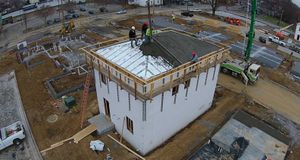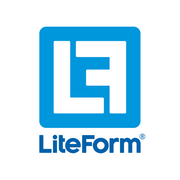3 Reasons to Use LiteForm ICFs to Build Your New Home
By LiteForm
Apr 01, 2019
As a builder, you want to lower that bottom line as much as you can without sacrificing the quality of the homes you’re constructing. While the residential standard is wood framing, insulated concrete forms (ICFs) like the ones made by LiteForm are quickly becoming a crowd favorite as a building system with a quick turnaround time and sheer superiority as a protective layer of a home.
Why You Should Build Residential Homes With LiteForm ICFs
1. A Continuous Insulation Barrier
 ICFs offer a tighter seal around a home than traditional insulation methods because the hollow forms—unlike more traditional, reusable concrete forms—are part of the final product. They are stacked and interlocked to frame the house, braced with rebars, and filled with concrete to lock everything in place. What results is an extremely energy-efficient system, with a 2.5-inch-thick foam block of insulation paired with a 4- to 12-inch-thick concrete slab at the core. LiteForm ICFs have an excellent R-rating—a measure of efficiency—of R-23, and they are durable, resisting decay to keep a structure sealed.
ICFs offer a tighter seal around a home than traditional insulation methods because the hollow forms—unlike more traditional, reusable concrete forms—are part of the final product. They are stacked and interlocked to frame the house, braced with rebars, and filled with concrete to lock everything in place. What results is an extremely energy-efficient system, with a 2.5-inch-thick foam block of insulation paired with a 4- to 12-inch-thick concrete slab at the core. LiteForm ICFs have an excellent R-rating—a measure of efficiency—of R-23, and they are durable, resisting decay to keep a structure sealed.
2. Quick, Custom, Cost-Effective Installation
LiteForm ICFs piece together as interlocking blocks, making their construction overall a straightforward process. Continuous furring strings and exclusive accessories help to expedite this set-up, allowing workers to construct the walls of a home quickly. This capability can lower a project’s budget for labor since its construction will take fewer days to build. LiteForm’s folding form technology also makes shipping this product cheaper than other ICFs on the market—roughly halving the number of trucks needed to ship them—and takes up to 55% less space on the construction site.
When matching the desired length for the walls, the insulated concrete form’s foam structure easily cuts with a saw, which also accommodates for the bracing of windows and door frames. With their custom assembly hardware, you can even create a space comprised of walls at any angle. Once they’re up, you then apply drywall and exterior layers like stucco or brick as you would to any other home.
3. The Health & Safety of Your Buyers
Typical basement walls are porous and allow pollutants like radon to seep into a home. They also can't ward off condensation, which can lead to dangerous mold and mildew. The tight seal that a LiteForm ICF system creates is mold resistant and keeps the inside of a home free of harmful pollutants that can seep through cracks in the insulation.
LiteForm ICFs also protects homeowners from the effects of severe weather and other disasters better than traditional wood framing. They have a wind resistance of up to 200 miles per hour, holding firm against strong gusts and debris that can hit a home. These insulated concrete forms protect against fires, as well, with a fire rating of 2 hours standard. Their superior insulation will also prevent the formation of ice dams, which can cause severe structural damage during winter. All of these considerations for the health and safety of your buyers are excellent selling points when you put the house on the market.
Create a residential home that’s built to last through all that life throws at it with insulated concrete forms and other building technology from LiteForm. Their state-of-the-art systems emphasize efficiency at every step of the way, with folding forms that reduce shipping costs and physical footprint on construction sites as well as excellent insulation once everything is in place. For more information about how their products can help create your client’s dream home, give them a call today at (402) 241-4402 or visit their website.
About the Business
Have a question? Ask the experts!
Send your question

